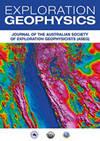Comparison of short-offset and long-offset grounded-wire transient electromagnetic responses based on the 3D model
IF 0.8
4区 地球科学
Q4 GEOCHEMISTRY & GEOPHYSICS
引用次数: 0
Abstract
AbstractIn this study, a recently developed time-domain electromagnetic method called the short-offset grounded-wire transient electromagnetic (SOTEM) method, which is a near-source observation method, was adopted to obtain strong signals and great detection depths. The responses of the SOTEM and long-offset transient electromagnetic (LOTEM) methods were compared to further guide and promote the SOTEM method. Currently, the comparison between SOTEM and LOTEM methods is primarily based on one-dimensional (1D) models. However, most geological bodies are three-dimensional (3D) structures. We investigated the responses of a grounded-wire transient electromagnetic method based on 3D models using the 3D finite-difference time-domain method. In addition, the signal strengths, detection sensitivities and detection depths of the SOTEM and LOTEM methods were compared. The results revealed that the field amplitudes of Ex (electrical component parallel to the transmitting source) and ∂By/∂t (magnetic component perpendicular to the transmitting source horizontally) were higher at the short offsets than at the long offsets. For the ∂Bx/∂t (magnetic component parallel to the transmitting source) and the vertical magnetic component ∂Bz/∂t, at initial times, the responses received would be stronger when closer to the transmitting source, whereas at later times, the responses would be stronger when farther from the source. Ex detection sensitivity increased with an increase in the offset at initial times, and increased with a decrease in the offset at later times. The detection sensitivities of the three magnetic field components at short offsets were higher than those at long offsets. The ∂By/∂t effective detection depth was the greatest. Generally, the effective detection depths of the three magnetic field components increased with decreasing offset. The range of the ratio of the horizontal distance, r, between the transmitting source and the target body to the effective detection depth H was 0.5-1.1.KEYWORDS: Transient electromagnetic methodgrounded-wire3D modellingSOTEM Disclosure statementNo potential conflict of interest was reported by the author(s).Additional informationFundingThis work was supported by the National Key R&D Program of China [grant number 2022YFC2903505]; Natural Science Foundation of China (NSFC) [grant number 42030106]; Science and Technology Project of Hebei Education Department [grant number QN2022041]; Fund from the Key Laboratory of Intelligent Detection and Equipment for Underground Space of Beijing-Tianjin-Hebei Urban Agglomeration, Ministry of Natural Resources [grant number ZB2022003]; Natural Science Foundation of Chongqing [grant number cstc2020jcyj-msxmX0676]; and National Pre-research Funds of Hebei GEO University in 2023 [grant number KY202301].基于三维模型的短偏置和长偏置接地线瞬变电磁响应比较
摘要本研究采用了一种新发展的时域电磁方法——短偏移接地线瞬变电磁法(SOTEM),它是一种近源观测方法,可以获得强信号和大探测深度。比较了SOTEM和长偏移瞬变电磁法(LOTEM)的响应,进一步指导和推广了SOTEM方法。目前,SOTEM和LOTEM方法的比较主要基于一维(1D)模型。然而,大多数地质体是三维构造。采用三维时域有限差分法研究了基于三维模型的接地线瞬变电磁法的响应。此外,还比较了SOTEM和LOTEM两种方法的信号强度、探测灵敏度和探测深度。结果表明,与发射源平行的电分量Ex和与发射源水平垂直的磁分量∂By/∂t的场幅值在短偏移量处大于长偏移量处。对于与发射源平行的磁分量∂Bx/∂t和垂直磁分量∂Bz/∂t,在初始时刻,离发射源越近,接收到的响应越强,而在以后的时刻,离发射源越远,接收到的响应越强。Ex检测灵敏度在初始时间随偏移量的增加而增加,在后续时间随偏移量的减少而增加。三种磁场分量在短偏移处的探测灵敏度均高于长偏移处。∂By/∂t有效检测深度最大。一般来说,三种磁场分量的有效探测深度随偏移量的减小而增大。发射源与目标体的水平距离r与有效探测深度H之比的取值范围为0.5 ~ 1.1。关键词:瞬变电磁法接地线三维建模sotem披露声明作者未报告潜在利益冲突。基金资助:国家重点研发计划项目[批准号2022YFC2903505];国家自然科学基金资助项目[批准号42030106];河北省教育厅科技项目[批准号QN2022041];京津冀城市群地下空间智能探测与装备自然资源部重点实验室[批准号ZB2022003];重庆市自然科学基金[批准号cstc2020jcyj-msxmX0676];河北地质大学2023年度国家预研基金项目[批准号:KY202301]。
本文章由计算机程序翻译,如有差异,请以英文原文为准。
求助全文
约1分钟内获得全文
求助全文
来源期刊

Exploration Geophysics
地学-地球化学与地球物理
CiteScore
2.30
自引率
0.00%
发文量
33
审稿时长
>12 weeks
期刊介绍:
Exploration Geophysics is published on behalf of the Australian Society of Exploration Geophysicists (ASEG), Society of Exploration Geophysics of Japan (SEGJ), and Korean Society of Earth and Exploration Geophysicists (KSEG).
The journal presents significant case histories, advances in data interpretation, and theoretical developments resulting from original research in exploration and applied geophysics. Papers that may have implications for field practice in Australia, even if they report work from other continents, will be welcome. ´Exploration and applied geophysics´ will be interpreted broadly by the editors, so that geotechnical and environmental studies are by no means precluded.
Papers are expected to be of a high standard. Exploration Geophysics uses an international pool of reviewers drawn from industry and academic authorities as selected by the editorial panel.
The journal provides a common meeting ground for geophysicists active in either field studies or basic research.
 求助内容:
求助内容: 应助结果提醒方式:
应助结果提醒方式:


